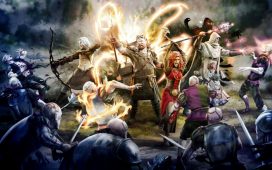15. Monkey Island 2: LeChuck’s Revenge (1991, LucasArts)
Of all LucasArts’ memorable, quip-fuelled point and click adventures – from dark afterlife comedy Grim Fandango to the surrealist Day of the Tentacle – it’s Monkey Island 2 that gets the most love nowadays, and justifiably so. The puzzles were just on the right side of deliberately obscure, the characters were strange and colourful, and the music unforgettable. And that ending still sparks discussion, 30 years on.
14. Gran Turismo (1997, Sony)

Although Ridge Racer and Daytona USA were vital in introducing the world to 32-bit, textured, 3D visuals, it is Polyphony Digital’s painstakingly authentic racing game that deserves a place here. With its exhaustive range of accurately modelled cars, its complex handling model and its emphasis on improving the player’s driving skills through a range of licence tests, Gran Turismo radically altered the course of console racing game design for ever.
13. Fallout 2 (1998, Black Isle Studios)
Released before post-apocalyptic settings became tired and boring, the original two Fallout games were brutal, intriguing, brilliantly written visions of a grim future for humanity. Emerging from a vault after nuclear devastation, you head out into the desert wastes and, most likely, get killed immediately by a giant scorpion. Manage to find other humans, though, and you’ll be treated to some of the darkest and funniest dialogue in games, as you try to talk or shoot or sneak your way out of trouble. Few modern RPGs offer as much true flexibility and choice as Fallout 2, though you can always expect the consequences of your actions to catch up with you quickly.
12. Resident Evil (1996, Capcom)

There had been horror adventure games before Resident Evil, but for Capcom’s title, designer Shinji Mikami merged exploitation cinema, expressionism, psychology and brilliant puzzle mechanics into one groundbreaking package. A key part of the game’s appeal was its many restrictions – the tank-like turning of the characters, the inaccuracy of the weapons and the stilted dialogue all made it feel like starring in your own tense, shocking and ridiculous cult horror video. And just look at the chilling legacy it begat.
11. Super Mario Kart (1992, Nintendo)
Mario’s first foray out of brightly coloured platforming worlds and behind the wheel of a go-kart introduced millions to the joy of couch multiplayer, and the sheer pain of slipping on a banana peel seconds before the finish line. Despite cheating AI racers and some truly evil courses based around Bowser’s castle, ghost houses and other locations from Mario’s main adventures, it always felt as if anyone had a chance of winning, especially if you were blessed by the item box roulette. Mario Kart remains one of the world’s bestselling games for a reason.
10. Street Fighter II (1992, Capcom)

On its SNES release in 1992, Street Fighter II made the multi-character fighting game an absolutely key genre, introducing a mainstream audience to Ken, Ryu and Chun-Li, and bringing us absolutely unforgettable attacks in the form of the Hadouken, Dragon Punch and Spinning Bird Kick. The sounds, moves and joystick rotations of this superlative sequel are burned into the memory banks of any game player who was there at the time, and they have carried this series unaged and still vibrant, through 30 years of fighting game evolution.
9. Tony Hawk’s Pro Skater (1999, Activision)
No game is more inherently 90s than THPS, the game that brought skate culture to the untouchably cool PlayStation. A ludicrously compelling, endlessly replayable arcade take on skateboarding, defined by the delight and agony of stringing mad combos of tricks together, only to flub the final landing and lose all those accumulated points. It was also an entire generation’s introduction to Goldfinger and the Dead Kennedys.
8. Sensible World of Soccer (1994, Sensible Software)
Some will think we should have gone for Speedball 2 (or Cannon Fodder or Worms), but the sequel to the already excellent Amiga classic Sensible Soccer is widely considered one of the greatest footie games ever made. The slightly slanted top-down perspective allows a perfect tactical view of the lightning-fast action, augmented by a superb control interface that made a huge variety of contextual moves available without the 16 buttons of a Fifa or PES title. Add in the thousands of differently skilled players and a complex management mode and you have a classic sports sim that’s just as playable today.
7. Sonic the Hedgehog (1991, Sega)

When Sega needed a mascot character to challenge Mario, coder Yuji Naka and designer Hirokazu Yasuhara rose to the challenge. Pushing the Mega Drive hardware to its limits they created a turbo-charged, multi-tiered, hyperreal platformer that blew apart Nintendo’s whole philosophy of good player experience. Sonic was impatient, boisterous and obnoxious – the perfect icon for early 90s teens, and the game world, from the luscious Green Hill Zone to the cyberpunk edge of Scrap Brain, reflected this attitude. Even now, the ascending opening chords of Masato Nakamura’s Green Hill theme carry that sense of exhilaration and the arm-folding, foot-tapping attitude of Sonic himself.
6. Pokémon Red/Blue (1996, Nintendo)
The games that kicked off a worldwide phenomenon that’s still going strong: who would have predicted at the time that a pair of strange black-and-white Game Boy role-playing games about collecting creatures would prove so wildly popular? Given that Pokémon is basically maths, requiring kids to memorise tables of strengths, weaknesses and move types, it might seem baffling that these games became such huge hits. But like all classic children’s fiction, they put kids in control, sending you out on an adventure with just your wits and your collection of critters to accompany you. Despite the bare-bones graphics, Kanto feels like a real place, and its native fauna teem with unexpected personality.
5. Quake (1996, Id Software)
Look, it was either going to be Doom or Quake – and while Id Software’s hellish 1993 blaster remains a landmark in so many ways, it was the follow-up that brought in a full 3D engine (which allowed new ways for players to exploit space – including the famed rocket jump), support for the emerging range of 3D graphics cards and, most importantly, robust online multiplayer gaming over the internet. It was dark and scary, with great sound effects and awesome weaponry and there were so many ways to play it and mod it. It felt like the future.
4. Final Fantasy VII (1997, Square)
The combination of cutesy in-game visuals with CGI-rendered movies may look incongruous now but by augmenting the game design mainstays of the Final Fantasy series with the cinematic visuals and symphonic CD sound of the PlayStation, Square set a lofty new benchmark for the Japanese role-playing genre. The story of Cloud and his band of ragtag mercenaries fighting the ecological destruction reaped by the Shinra Electric Power Company is filled with emotion, drama and political resonance that still shocks and moves today. There have been better FF titles since, but this was the dawn of the modern JRPG era.
3. Half-Life (1998, Valve)

From its cold-open on a monorail train journey to tense ventures through a dark, devastated lab facility while frantically beating off alien headcrabs with a crowbar, Valve’s masterpiece of a first-person shooter helped write the rulebook for how games tell their stories without resorting to aping the conventions of film. In ditching the marine/superhero convention of shooter protagonists and putting you in the shoes of everyman scientist Gordon Freeman trying to survive as horrendous creatures scuttle around just out of sight, it also helped evolve the genre beyond recreated wars and power fantasies.
Where 1992’s A Link to the Past had us teleporting between light and dark versions of the fantasy world of Hyrule, Ocarina of Time had us time-travelling instead. Young Link walks out into the verdant expanse of Hyrule Field in search of a princess who appears in his dreams; later, teen Link emerges from the Temple of Time to find that world cruelly ravaged. Ocarina of Time’s technical innovations truly changed what people expected of video game worlds, but it was also extraordinarily atmospheric and eerie, an experience that could be as haunting as it was playful. A game that truly felt like a world.
1. Super Mario 64 (1997, Nintendo)

Mario began the decade by unleashing the astonishing technicolor 2D platforming genius of Super Mario World on the SNES, but in 1997, it changed video games for ever with Super Mario 64. Little compared to the absolute joy of running and leaping Mario around in three dimensions for the first time, exploring the strangely angular, polygonal playgrounds of this landmark game. Super Mario 64 became the template for all 3D platformers, and despite Lakitu’s dodgy camerawork, it’s still one of the very best ones ever made.














